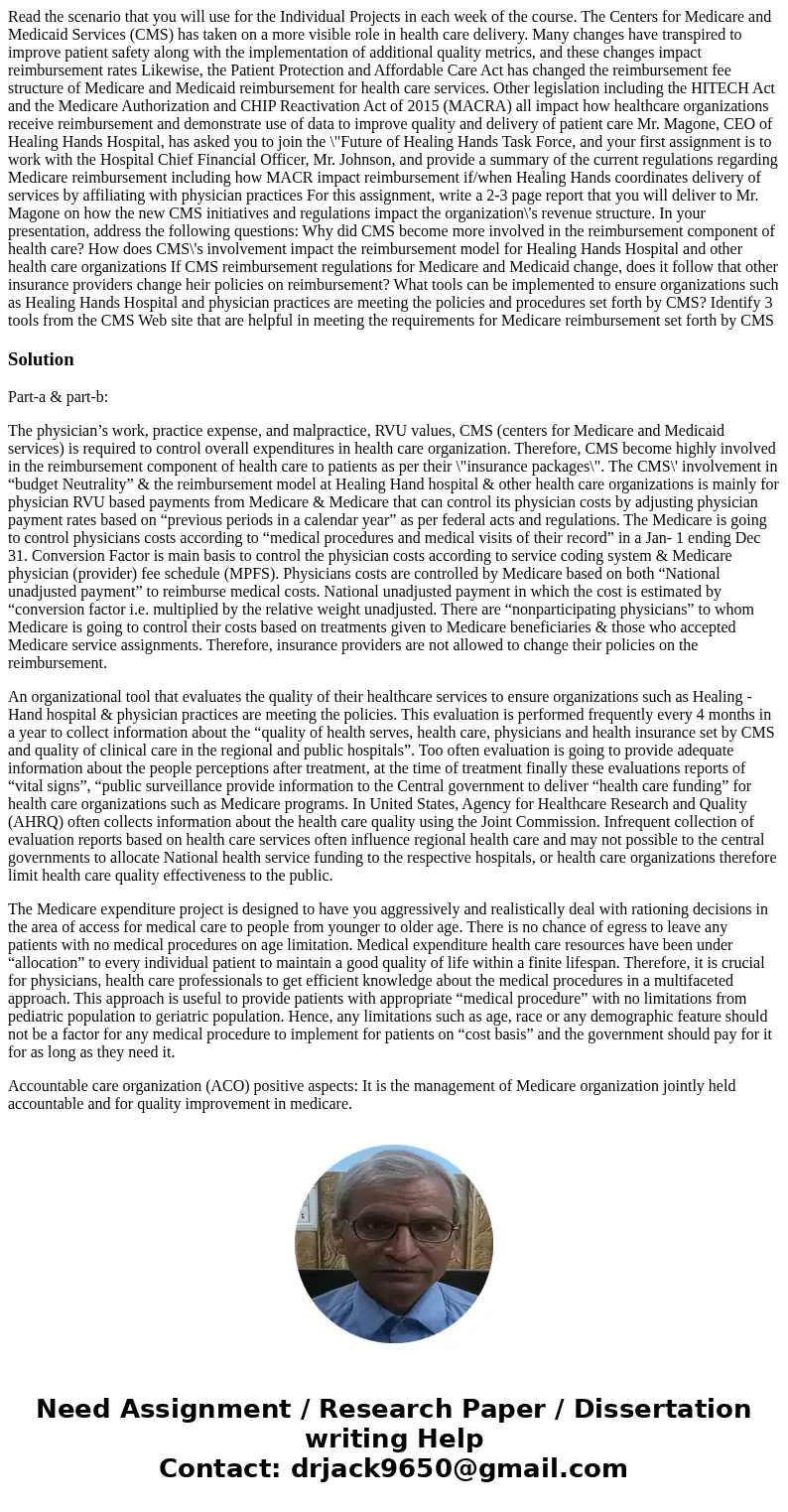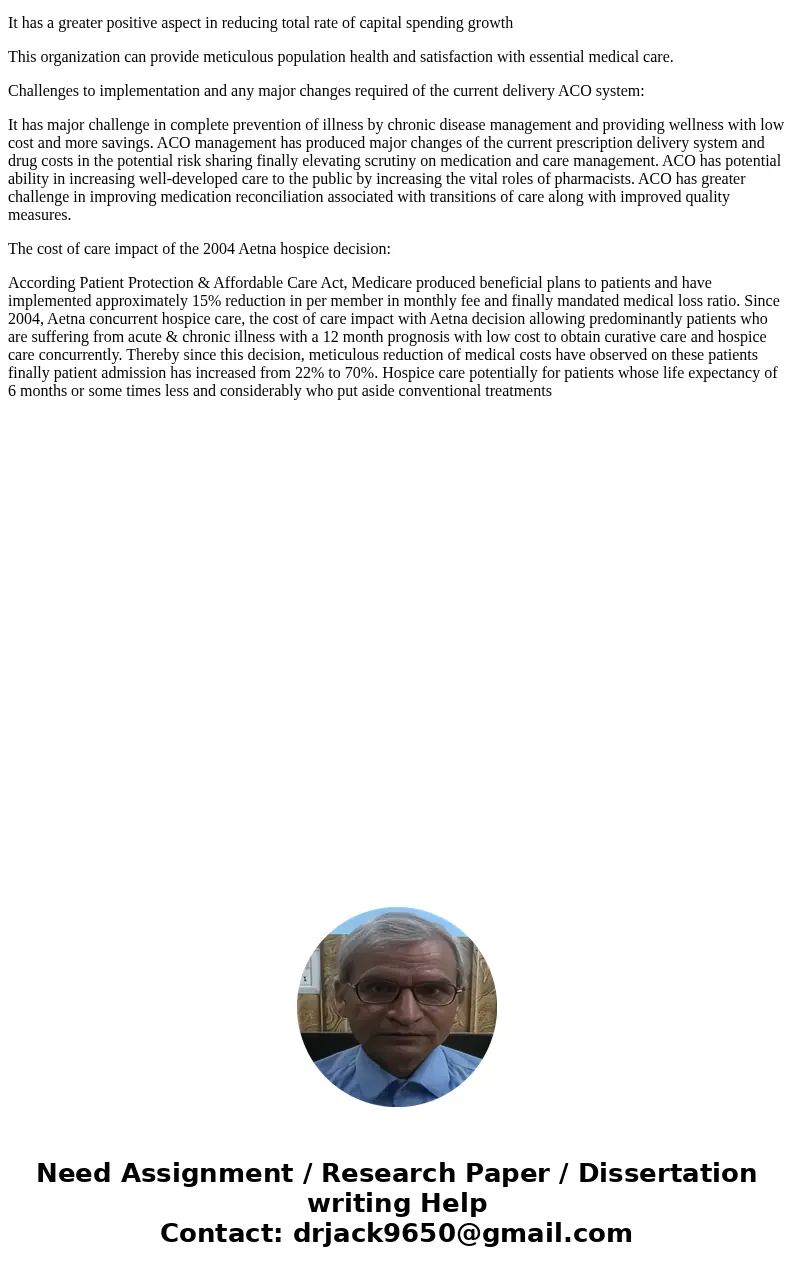Read the scenario that you will use for the Individual Proje
Solution
Part-a & part-b:
The physician’s work, practice expense, and malpractice, RVU values, CMS (centers for Medicare and Medicaid services) is required to control overall expenditures in health care organization. Therefore, CMS become highly involved in the reimbursement component of health care to patients as per their \"insurance packages\". The CMS\' involvement in “budget Neutrality” & the reimbursement model at Healing Hand hospital & other health care organizations is mainly for physician RVU based payments from Medicare & Medicare that can control its physician costs by adjusting physician payment rates based on “previous periods in a calendar year” as per federal acts and regulations. The Medicare is going to control physicians costs according to “medical procedures and medical visits of their record” in a Jan- 1 ending Dec 31. Conversion Factor is main basis to control the physician costs according to service coding system & Medicare physician (provider) fee schedule (MPFS). Physicians costs are controlled by Medicare based on both “National unadjusted payment” to reimburse medical costs. National unadjusted payment in which the cost is estimated by “conversion factor i.e. multiplied by the relative weight unadjusted. There are “nonparticipating physicians” to whom Medicare is going to control their costs based on treatments given to Medicare beneficiaries & those who accepted Medicare service assignments. Therefore, insurance providers are not allowed to change their policies on the reimbursement.
An organizational tool that evaluates the quality of their healthcare services to ensure organizations such as Healing - Hand hospital & physician practices are meeting the policies. This evaluation is performed frequently every 4 months in a year to collect information about the “quality of health serves, health care, physicians and health insurance set by CMS and quality of clinical care in the regional and public hospitals”. Too often evaluation is going to provide adequate information about the people perceptions after treatment, at the time of treatment finally these evaluations reports of “vital signs”, “public surveillance provide information to the Central government to deliver “health care funding” for health care organizations such as Medicare programs. In United States, Agency for Healthcare Research and Quality (AHRQ) often collects information about the health care quality using the Joint Commission. Infrequent collection of evaluation reports based on health care services often influence regional health care and may not possible to the central governments to allocate National health service funding to the respective hospitals, or health care organizations therefore limit health care quality effectiveness to the public.
The Medicare expenditure project is designed to have you aggressively and realistically deal with rationing decisions in the area of access for medical care to people from younger to older age. There is no chance of egress to leave any patients with no medical procedures on age limitation. Medical expenditure health care resources have been under “allocation” to every individual patient to maintain a good quality of life within a finite lifespan. Therefore, it is crucial for physicians, health care professionals to get efficient knowledge about the medical procedures in a multifaceted approach. This approach is useful to provide patients with appropriate “medical procedure” with no limitations from pediatric population to geriatric population. Hence, any limitations such as age, race or any demographic feature should not be a factor for any medical procedure to implement for patients on “cost basis” and the government should pay for it for as long as they need it.
Accountable care organization (ACO) positive aspects: It is the management of Medicare organization jointly held accountable and for quality improvement in medicare.
It has a greater positive aspect in reducing total rate of capital spending growth
This organization can provide meticulous population health and satisfaction with essential medical care.
Challenges to implementation and any major changes required of the current delivery ACO system:
It has major challenge in complete prevention of illness by chronic disease management and providing wellness with low cost and more savings. ACO management has produced major changes of the current prescription delivery system and drug costs in the potential risk sharing finally elevating scrutiny on medication and care management. ACO has potential ability in increasing well-developed care to the public by increasing the vital roles of pharmacists. ACO has greater challenge in improving medication reconciliation associated with transitions of care along with improved quality measures.
The cost of care impact of the 2004 Aetna hospice decision:
According Patient Protection & Affordable Care Act, Medicare produced beneficial plans to patients and have implemented approximately 15% reduction in per member in monthly fee and finally mandated medical loss ratio. Since 2004, Aetna concurrent hospice care, the cost of care impact with Aetna decision allowing predominantly patients who are suffering from acute & chronic illness with a 12 month prognosis with low cost to obtain curative care and hospice care concurrently. Thereby since this decision, meticulous reduction of medical costs have observed on these patients finally patient admission has increased from 22% to 70%. Hospice care potentially for patients whose life expectancy of 6 months or some times less and considerably who put aside conventional treatments


 Homework Sourse
Homework Sourse